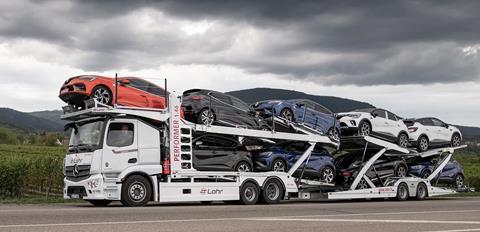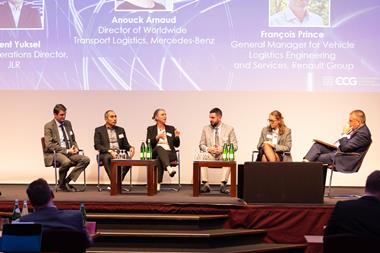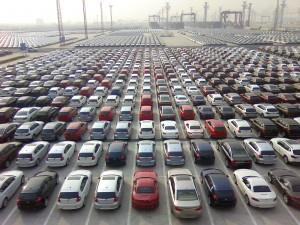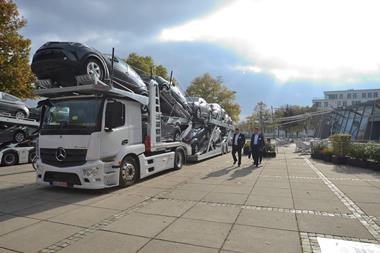Finished vehicle carrier equipment manufacturers and transport providers have asked for a grace period to adjust to new standards on vehicle lashing that have been drawn up by Germany’s VDI standards association.

Car haulers and equipment makers in Europe are having to adjust quickly to new technical standards on lashing vehicles to trailers which were brought in by the German VDI standards association and German regulators on September 1. Many are asking for more time to bring equipment up to the new standards.
Parts 8.1 and 8.2 of VDI Guideline 2700 apply to load securing on car carriers but the existing guidelines published in 2009 were missing specifications on lashing points, strap design and hooks, and the required blocking forces for wheel chocks, among other details.
Vehicle transporters have to be certified in accordance with VDI 2700 Sheet 8 on four points: tension straps, wheel chocks, the friction co-efficient track element and dynamic driving tests. The track element is the distance between the centre line of two wheels on the same axle. Every vehicle must be inspected once a year to check the attachment components are up to specification, and upgrades and repairs can only be carried out by the authorised equipment manufacturer. That includes the trailer manufacturers and the load securing equipment manufacturers, who have to provide the user with maintenance instructions for the load securing equipment used on the vehicle body.
The update to the guidelines means that equipment standards for carrying passenger cars, light commercial vehicles and heavy goods vehicles have to be revised to be ‘state-of-the-art’. To this end, a technical working group was set up under the leadership of the VDI, TÜV SÜD and a range of car transporter manufacturers (see box) to test and revise the requirements. Those revisions were applied immediately on request from police authorities in Germany and by OEMs eager to comply with legal requirements for shipping their vehicles.
Companies included in testing and investment project
Allsafe, Dolezych, FGS, FMS Fahrzeugbau, FVG, Hödlmayr High and Heavy, Kässbohrer, Lohr, Moetefindt, Rimo, Rolfo, SpanSet
Time to upgrade

However, equipment manufacturers and transport providers have asked for a grace period to adjust, notably for those companies that need to upgrade existing equipment. In a webinar hosted by the Association of European Vehicle Logistics (ECG), Edgaras Bubnelis, head of sales at Rimo, one of Europe’s largest car carrier manufacturers, said 1,500 of its trucks needed to be serviced and 44% had already registered for the new certificate. However, at the end of September only 8% of those who had applied had completed everything required for full compliance.
Bubnelis said the car carrier sector needed OEMs and legal enforcement bodies to grant a period of some months to let those who were not yet prepared to get the upgrades in place before being penalised.
Eric Belton, managing director of Lohr Automotive, noted that bodybuilders had received requests for equipment upgrades prior to September 1 but he estimated (as of the end of September) that Lohr had only received requests for the certificates from roughly 35-40% of the total number of vehicles needing the certificate. Belton said that if Lohr received the missing 60% of requests it was organised to respond prior to the end of the year to all of them.
Belton said that transport equipment introduced on the market over the last 12-15 years is compliant with the certificate but the demand for additional accessories such as straps and wheel chocks was causing a bottleneck in supply. “Establishing the certificate is one element that requires a lot of administrative work, especially given the high demand and short amount of time to respond to it, but it is the same for the supply of the additional accessories,” said Belton. He said that equipment and lashing suppliers were working hard to get that supply through but it would take some time.

Belton added that a welcome sign would be for the OEMs to show some understanding to their transport and equipment providers because equipping thousands of transport vehicles with the necessary accessories within a very short amount of time is a very tough challenge.
German specifications across Europe
Parts 8.1 and 8.2 of the VDI guidelines apply to car carriers moving within, to or from Germany, or transiting through it. However, it also applies beyond Germany because there are no corresponding guidelines on what constitutes state-of-the-art equipment for car carriers at the European level.
Sylvia Freitas, who is responsible for the Auto Plus Load Securing Division at the testing and certification body TÜV SÜD, said that, according to the 2009 version of VDI 2700, car carriers had to secure a vehicle with up to three axles and 5 tonnes using three web lashings and four wheel chocks. However, that often resulted in damage during the securing process as the forces applied were too high for the metal panels. “We then determined the minimum requirements, noting that the angle of inclination of the loaded vehicle is very important for load securing,” she said. “The result was slightly different – four web lashings and six wheel chocks.”
Stefan Meixner, head of development of special vehicles at equipment maker Kässbohrer Transport Technik, said that one of the big questions was why the old VDI guidelines were not safe anymore. He said that in general cargo transport there is a big difference in the number of lashings for a pallet that is 100km and one that is 4,000kg.
“This was the biggest missing link on the old VDI standard from 2009 – there were no numbers for the friction, no values for the wheel chocks, for the lashing straps and blocking forces, or for the lashing points values for the track elements,” he said. “This was a big safety issue for all bodybuilders to find out what is possible and what is the minimum standard.”

Meixner said it was now very important for the customer to know they can reach the certification of the truck, something that is available on Kassbohrer’s website, as with other bodybuilders.
Non-compliance with the new standard means shippers, vehicle owners and the drivers can be penalised with fines, just as are German shippers, drivers and owners. That includes an on-the-spot fine and a point on the driver’s record. According to Freitas, checks on the road have been made since the new guidelines started on the September 1. “It is entirely at the discretion of the police how strict the checks are right now on the roads and we can’t say how strictly they are already controlling it [but] this guideline is now the basis for those checks,” said Freitas.
The checks are based on paragraph 22 of the German road traffic regulations, where it is stated that: “The load, including load-securing devices and loading equipment, must be stowed and secured in such a way that they cannot slip, fall over, roll back and forth, fall down or generate avoidable noise, even in the event of emergency braking or sudden evasive manoeuvres. The recognised rules of this technology must be applied.”
State-of-the-art without transition
The problem is that there is that German legislation does not provide for any transition period to allow carriers to comply with the technical standards required. Simon Jäckel, standardisation production manager at the VDI, told attendees of the ECG webinar that the aim of the body is to recognise technical standards defining what is state-of-the-art transport equipment. As with the ISO international standardisation or the CEN standardisation across Europe, the task of VDI is to document and publish what is state-of-the-art through voluntary collaborative work based on the principle of consensus and involving all interested parties.
“Technical standards are voluntary in their application and do not by themselves include any transition periods,” said Jäckel, adding that none of its 2,200 standards have transition periods. “However, if technical standards are made mandatory through laws or contracts, they must be followed,” he said. German legislation dictates that load securing must be done to technical standards but it does not provide for any transition period…[.] There is no transition period from our side or from the German legislators.”
With the technical standards published, the OEMs wanted the standards to be followed from day one as did some police departments in Germany. “They decided the standards must be followed from day one and checked on the German highways,” confirmed Jäckel.
While equipment providers and their customers look to the OEMs for understanding on the time needed to adjust to the updated standards, the establishment of the new specifications and the inclusion of additional accessories bodes well for the future of vehicle haulage in Europe, notably as passenger cars become heavier with the move to electrification.
New VDI attachment standards for car carriers
VDI 2700
Part 8.1 [passenger cars/LCVs]
- Must comply with DIN EN 12195-2
- Elongation ≤4%
- LC: 1,500 daN
- STF: 330 daN
- Webbing width at least 35mm
- The ETA value of the web lashing/anti slip device configuration must indicated on the label
- The lashing hooks must be approved for the ramp elements
Part 8.2 [heavy commercial vehicles]
- Must comply with DIN EN 12195-2
- Elongation ≤4%
- LC: 2,500 daN
- STF: 500 daN
- Webbing width at least 50mm
- The ETA value of the web lashing/anti-slip device configuration mus be indicated on the label
- The lashing hooks must be approved for the ramp elements

























![Global[1]](https://d3n5uof8vony13.cloudfront.net/Pictures/web/a/d/s/global1_726550.svgz)













No comments yet